Sun 27 Sep 2020
You only need two tools in life: WD-40 and duct tape. It it doesn’t move and should, use the WD-40. It it shouldn’t move and does, use the duct tape.
Sun 27 Sep 2020
You only need two tools in life: WD-40 and duct tape. It it doesn’t move and should, use the WD-40. It it shouldn’t move and does, use the duct tape.
Sat 26 Sep 2020
Almost literally. I lost my footing and fell on Thursday, breaking my fall with my left arm, but wrenching my wrist badly enough that my arm is now all wrapped up in whole cloth from elbow to near finger tips. The general assessment is that it will be a week before it comes off. The cast, not the arm. I can type with one hand, but it’s not fun, especially when I need a capital letter every now and then. So, I’m sorry to say, taking a break is the operative term. Except for an occasional update, I’m sure, I’ll see you on the other side.
Fri 25 Sep 2020
THE STRANGERS IN 7A. Made for TV film. CBS, 14 November 1972. Running time: 74 minutes. Cast: Andy Griffith (Artie Sawyer), Ida Lupino (Iris Sawyer), Michael Brandon (Billy), James A. Watson, Jr. (Riff), Tim McIntire (Virgil), Susanne Benton (Claudine; billed as Susanne Hildur), Connie Sawyer (Mrs. Layton), Virginia Vincent (woman in bank). Writers: Eric Roth, based on the novel by Fielden Farrington. Music: Morton Stevens. Producers: Mark Carliner Productions and Palomar Pictures International. Director: Paul Wendkos.
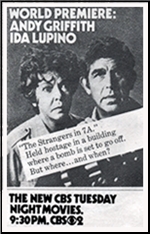
Artie Sawyer is the superintendent of an apartment house. The marriage between him and his wife Iris has taken a downturn, so when she leaves town to visit her sister, Artie moseys down to the local bar to “relax.” It isn’t long, however, before his relaxed mood is dissipated when he encounters Claudine, a pretty young thing who uses every available (and some not readily available) feminine wile to coax Artie into letting her spend the night in one of his apartments — at which she is predictably successful, since it’s plainly obvious what’s on Artie’s mind.
It’s while she and Arnie are experiencing a really close encounter with each other that three men (with, we soon learn, brief cases containing sawed-off shotguns and something even more explosive) barge in and spoil the mood; the only thing these three have on their minds is that $800,000 in the vault of the bank that just happens to be next door to Artie’s apartment house . . .

And that’s the first third of this movie, which takes its time to get moving. Like John Payne and Dick Powell before him, Andy Griffith must have been anxious to change his well-established small-town persona to something a little more adult and cashable; this one succeeds in doing that by having Griffith’s character engage in an extra-marital affair — although, to be clear, there isn’t enough time for it to go anywhere. Griffith would later do a few more made for TV films like this one before landing the plum role of Matlock.
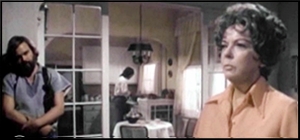
The most impressive cast member isn’t Ida Lupino, ordinarily a splendid actress and director, who surprisingly doesn’t have much to do here. The standout is Michael Brandon, who almost steals the show as the passive-aggressive ring leader; what happens to his character is fitting but comes off as anticlimactic considering what has gone before.
All in all, The Strangers in 7A is a fairly standard but efficient low budget caper movie; no plot surprises, of course, but well acted and definitely not a waste of time. It’s available on video from Synergy Entertainment and, for now, YouTube’s Cult Cinema Classics channel.
Thu 24 Sep 2020
1. Dead Man’s Bay by P. M. Hubbard. BBC Saturday Night Theater.
2. Fire, Burn by John Dickson Carr. BBC Saturday Night Theater.
3. The Silver Mistress by Peter O’ Donnell. 15 Minute Serial in 5 Parts
Radio drama lasted far longer outside the US in most countries with the BBC keeping up the tradition even today with adaptations of Ian Fleming’s James Bond novels and recently Raymond Chandler’s Philip Marlowe (both starring Toby Stephens who replaced Ed Bishop as the BBC’s Marlowe) among others and even the Saint in adaptations of Leslie Charteris’s novels.
The great thing is many of these shows both modern and from the past are available to listen to on YouTube and at Internet Archive presenting a rich mixture varying from classic mystery, romance, adventure, science fiction, horror, and mainstream plays and books, sometimes with unknown cast and others more familiar names.
BBC’s Saturday Night Theater was a rich series producing original and adapted radio dramas from a variety of sources including many outstanding mystery writers.
P. M. Hubbard (Philip Maitland Hubbard) was a successful mystery writer whose career, though short (1963 to 1979) included numerous highly regarded suspense and adventure novels such as Kill Claudio, High Tide, The Dancing Men, and Causeway Bay, varying from international intrigue, to straight adventure, to some decidedly left hand turns into near Gothic or horror fiction along the way.
Dead Man’s Bay is an original play written by Hubbard for the BBC about Peter Robinson, an ordinary fellow who falls in with Joe Benson, a bad sort, who convinces Peter, against the wishes of his wife Letty, that his beloved sail boat and knowledge of local waters means he could pick up some much needed money with a little side of smuggling.
Avoiding the excise man is an old British tradition practiced less as crime than a sort of game played for centuries by British smugglers and subject of many a classic tale from Daphne DuMaurier’s Jamaica Inn to Graham Greene’s The Man Within, Russell Thorndyke’s Dr. Syn books, and Geoffrey Household’s comedic “Brandy for the Parson.â€
Also along the rugged coast where Peter plies his game with the Inland Revenue is a top secret British installation referred to only as The Establishment. Peter and Letty’s close friend Jim Hardwicke is in charge of security there and Peter’s wastrel brother Ricky, who knew and loved Letty before she met Peter, a Naval officer under him.
But when Joe Benson reveals to Peter he has really been smuggling dope in from France and threatens blackmail to force Peter to make one last run and something occurs at the Establishment that has police roadblocks up all over the area Peter confronts something more sinister than even dope smuggling and a heartbreaking choice.
There are no surprises in the story. You will likely be well ahead of the cast in figuring where it is going, but the story is told in bright smart dialogue and the atmosphere and storytelling make for an entertaining and vivid drama.
Fire, Burn, John Dickson Carr’s classic historical mystery comes with a strong adaptation by John Kier Cross (author of, among others, a fine collection of his own weird fiction), and explores once again Carr’s fascination with the Berkeley Square (after the classic play and films) plot device of a romantic minded man thrown back in time through little but sheer will and his adventures there.
This time the gentleman is Scotland Yard’s John Cheviot who gets in a taxi in 1960’s (the date of the radio play) London and after a bump on the head finds himself in 1829 London just appointed to the newly formed Police under Robert Peel as Superintendent of the Detective Force, and for his first case assigned to solve the mystery of who stole the bird seed from an influential dowager.
Almost before you or Cheviot can digest this humiliation, he finds himself witness to an impossible crime, the murder of one Margaret Renfield (a witcherly type of whom Edmund Kean, the actor, once quipped ‘Fire burn and cauldron bubble’ in reference to), concealing evidence to protect his mistress, dueling with the most dangerous man in London, and determined to use modern methods to solve the crime, even though he is rapidly forgetting the John Cheviot from the 1960’s.
Cross manages to hit all the right notes from the novel in a quickly paced hour and eighty six minutes, replete with a raid and brawl in a London gaming house, and a classic impossible crime solution. There is even an epilogue from the book explaining who was real in the story and the real life crime Carr based the book’s solution on.
You can almost feel the fog in your chest and see the gaslit streets of 1829 London.
There have been five books in the Modesty Blaise series adapted for the fifteen minute daily serial, a BBC feature that tends toward lighter popular fare, but with no letup in quality. These are faithful adaptations of the popular books with Modesty and Willie Garvin and the other characters from the books brought vividly to life.
The Silver Mistress came about midway in the book series and features Modesty and Willie’s friend and sometime boss Sir Gerald Tarrant kidnapped and held prisoner in the haunted mountainous region of France. Along with Tarrant’s aide Fraser they set out to find Tarrant and rescue him leading to one of Modesty’s most deadly fights in the darkness of an underground cave system with a freezing cold river running through it.
As you can imagine the radio drama plays that scene for full blooded fun.
All the Blaise adaptations have been good and faithful, but this one works particularly well as radio drama.
Radio drama differs from audiobook versions of the same material in that it moves at a much faster pace (it can take up to eleven hours or more to listen to many audiobooks), and because a good radio play choreographs not only the dramatic highlights, but also allows for a varied cast of talented voice actors to bring the material to life.
Entertaining as it can be for an author or actor to perform an audiobook well (Stacy Keach reading Mike Hammer or Kevin Conroy Travis McGee come to mind), it can’t rival a cast of talented actors and sound crew giving full performances.
There are many other examples to sample easily found at the two sources I mentioned including books by Mary Stewart, Margery Allingham, Agatha Christie, Andrew Garve, Michael Gilbert, Joyce Porter, C. S. Forester, and many other names familiar to this blog. It’s a particularly attractive way to revisit an old favorite you might not want to reread, but one you don’t want to forget either and often adds a new dimension to the original.
Wed 23 Sep 2020
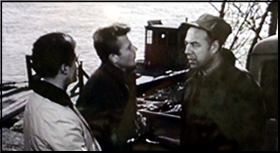
ROUTE 66. “Black November.†CBS, 60m, 07 Oct 1960 (Season 1, Episode 1). Martin Milner (Tod Stiles), George Maharis (Buz Murdock). Guest Cast: Everett Sloane, Patty McCormack, Keir Dullea, Whit Bissell, George Kennedy. Musical theme: Nelson Riddle. Screenwriter: Stirling Silliphant. Director: Philip Leacock. Currently streaming on Amazon Prime Video.
Chronicling the adventures of two roving buddies making their way across the width and breath of the United States, this was arguably the iconic TV shows of the early 1960s. Of its kind, while I personally missed it entirely, it was certainly the most successful. I was off in college at the time, and I think I had time to watch television at most two or three, with the choice limited to one TV channel.
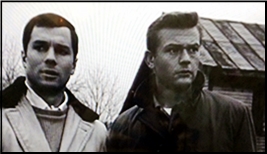
I knew about it, of course, even without access to our family’s subscription to TV Guide, which I was addicted to all though high school. (Who in the early 60s did not?) So when I learned that Amazon Prime was streaming it free to subscribers, I thought it high past time to catch up on a serious lack in my cultural heritage.
I’m glad I did. This first episode’s a good one. The two buddies with a brand new car and two pair of restless feet to drive it find themselves in quite a predicament – at one time with ropes around their necks waiting to be lynched. This is not anything the Mississippi Tourist Bureau would want anyone to see! I suppose that in 1960, backward places such as the small town of Garth might exist, just like the most secluded rural parts of England, where strangers never come, and when they do, they are looked on by residents as Demons from Hell.
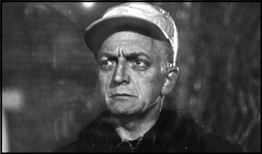
One man rules the town with a iron thumb, and his name is Garth (Everett Sloane). The town also has a secret, but absolutely no one will talk about it. The daughter (Patty McCormack) of the local storekeeper is the only one who offers them a timid, shy smile. Everyone else has dark sullen faces, constantly staring at the pair with dark hostility. There is also, of all things, but it fits in perfectly, a creepy scene in which the townsfolk storm the grocery store with torches blazing away in the darkness.
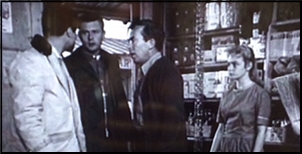
As the pilot episode, this certainly is an effective one. It starts, however, after they’ve already been on the road for a while, and it’s only in their conversation that we get hints of who they are and what set them on their way. If you are puzzled why they were heading for Biloxi before they got lost, a town nowhere near Route 66, I have often wondered that about the series myself. They ended up all over the US during the four years the program was on the air. I have finally assumed that the cross-country Route 66 was only a metaphor for anyone traveling here and there at whim and will, with no particular destination in mind.

Wed 23 Sep 2020
KIERAN SHEA “The Lifeguard Method.†Charlie Byrne #1. First published in Ellery Queen’s Mystery Magazine, August 2009. Probably never collected or reprinted.
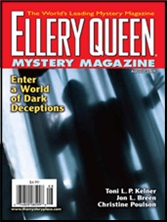
This is both Kieran Shea’s first published story and (of course) the first recorded case of PI Charlie Byrne. Although most of the story takes place in a room at the Trump Taj Mahal in Atlantic City, Byrne seems to be permanently based in Philadelphia. Most of his work is for hotshot litigator there, having saved his son Andy from drowning while working as a lifeguard at a beach when the boy was only six.
Andy is now in his early 20s and is foolishly trying to scam his father out of fifty grand by faking his own kidnapping. Byrne is having none of it, but makes the initial mistake of taking everything for granted, a mistake he doesn’t make twice.
In her introduction to the story, the editor points out that it was difficult to decide whether to put this tale in their Department of First Stories, or in their “Black Mask†section. They chose the latter, and it was a good choice. Without being able to say more, this is one of the most hard-boiled stories I’ve read in a long time.
It was also stated in the introduction that the author was working on a novel involving Charlie Byrne, but if so, it may have never been completed. There was one more appearance for this otherwise one-shot PI, that being “Shift Work,†which was serialized in three parts in an ezine titled Crime Factory, March, May & July 2010.
Tue 22 Sep 2020
DONNA LEON – Trace Elements. Commissario Guido Brunetti #29. Atlantic Monthly Press, hardcover, March 2020. Setting: Contemporary Venice.
First Sentence: A man and a woman deep in conversation approached the steps of Pone dei Lustraferi, both looking hot and uncomfortable on this late July afternoon.
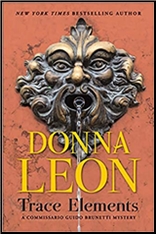
Benedetta Toso, a dying hospice patient who asks to speak with the police, claims her husband, Vittorio Fadalto, was murdered over “bad money.†Commissario Brunetti and his colleague, Claudia Griffoni, promise to investigate the matter, but was it murder or an accident? Suspicions mount as they learn more about Vittorio’s job, that of collecting samples of water to be tested for contamination. Piecing together the tangled threads, Brunetti comes to realize the perilous meaning in the woman’s accusation and the threat it reveals to the health of the entire region.
With an excellent beginning, one learns that being a Neapolitan in Venice is a “far greater handicap than being a woman.”— and that one may not want to visit Venice during the summer. Leon’s voice is always a pleasure. When talking about the heat, she conveys the sense of it without referencing it directly– “Brunetti realized only then how hot he was. He tried to lift his right leg, but it was glued to the chair by sweat.” It is these touches that bring Venice to life by allowing us to see the city as those who live there do.
There is a second plot thread of two Romany pickpockets. It is interesting to learn the differences between how crimes are handled in Italy versus the United States. The secondary plot does raise interesting points. Leon’s descriptions, from the route to an address Brunetti takes that only a resident would know, to his description of a room badly decorated, to food, are a delight and bring the city to life. Even a plate of sandwiches at a bar sound good– “From the sides of the sandwiches spilled ham, egg tomato, tuna salad, radicchio, rucola, shrimp, artichokes, asparagus, and olives.”
Leon is wonderful at injecting verbal exchanges to make one chuckle. When called into his boss’s office, Signorina Elettra remarks– “If you aren’t out in fifteen minutes, I’ll call the police.” However, she is also very good at making one pause and consider, as with Bruno’s conversation with a nurse– “But if you work with death, you have to become spiritual, or you can’t do it any more. … when they get close to the end, you can sense their spirit, or you sense that it’s there. They do, too. And it helps them. And us.” She knows how to touch one’s emotions– “Griffoni…raised a hand and threw open her palm, as if to release the dead woman’s spirit into the air. The three of them remained silent for enough time to allow that spirit to escape the room…”
There is something wonderful about a policeman who reads Lysistrata for pleasure and describes Agamemnon as a “windbag commander.” The relationship between Brunetti and his wife Paoli adds normality. It is one of a couple who have been married a long time and still love one another. An interesting characteristic of Leon is that when her characters are in a professional setting, she references them by their surnames, yet when in a personal setting, or amongst one another as friends, she uses their first names.
Leon is incredibly good at building a story. She takes one along with her through the steps with an amazing subtlety to the clues. Trace Elements is a police procedural without car chases or gunplay, but with a somewhat political theme. It is a very contemporary mystery with a contemporary crime. It reflects on the degradation of true justice in our time and on compromise. For some, the ending may not seem satisfactory, but upon reflection, there is some small justice amidst justice that cannot be achieved.
Rating: Very Good.
Mon 21 Sep 2020

COMMISSIONER MANARA. “The Perfect Crime (Un delitto perfetto).†Rai 1, Italy, as Il commissario Manara. 08 January 2009 (Season 1, Episode 1.) Guido Caprino (Luca Manara), Roberta Giarrusso (Lara Rubino), and a large ensemble cast. Currently streaming on Amazon Prime as Inspector Manara.
Commissioner Manara, a delightful combination of comedy and sentimental police work, appeared on Italian TV for two seasons of twelve episodes each. In this, the first episode, Luca Manara has been sent down from the big city to take over as Commissioner in a small provincial town where his arrival is looked on with considerable suspicion, especially since one of the officers still there had expected to be offered the job.
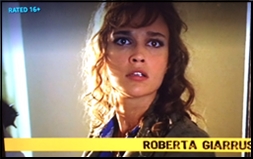
Luca is, as it turns out, something of a playboy and a womanizer. He reputedly had to leave his previous position for romancing the wife of his superior there. Young, dressed rather informally, with a carefully maintained stubble of a beard, plus a propensity for riding a motorcycle everywhere, he is often taken for a delivery person. When his new inspector sees him, she immediately slaps him in the face. It seems that they have had a past together, back in inspector school.
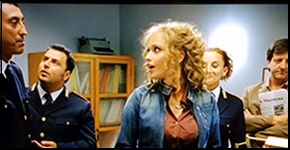
The first case they have to work on together is that of a death that is at first assumed to have been a suicide, but between Luca’s good instincts and even better forensic work, it is soon discovered that it was murder instead, much to the local superintendent’s displeasure.
I really enjoyed this one. There is both laugh-out-loud comedy and excellent detective work involved, plus a sentimental ending that shows everyone that Luca Manara also has the proverbial heart of gold. Add in lots of beautiful scenery and even more beautiful women, what’s not to like?
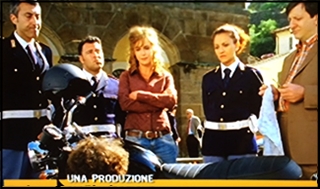
Mon 21 Sep 2020
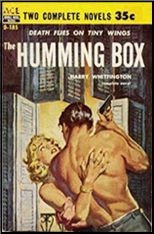
HARRY WHITTINGTON – The Humming Box. Ace Double #D-185, paperback original, 1956. Published back-to-back with Build My Gallows High, by Geoffrey Homes.
I recently revisited a book I picked up back in College. I was pretty wild back in those days, you see, and my gang and I would sometimes get in an old jalopy, pool money for gas, and tear up to Cleveland, where we’d spend the day prowling the seedier parts of town, scouting out Used Book Stores and whistling at girls. Or maybe we just scouted out Used Book Stores. It’s been a long time, Anyway, on one of these raids, I picked up Ace Double #D-185 featuring The Humming Box by Harry Whittington. Inside the front cover, the blurb page offered a Cast of Characters, including:
LORNA PALMER: A modern Pandora. Her box was no myth!
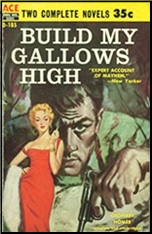
Ah, the things they used to get away with in those days! Anyway, The Humming Box is better than it sounds, despite the pulpy plot (Everyone in it seems to be plotting to murder somebody, though none of them are much good at it.) and the lurid packaging. Whittington works some really creepy scenes from the (rather timely) concept of a package of disease-carrying mosquitoes smuggled out of Korea by a psychotic GI, then fallen into the hands of a scheming heiress who’s being blackmailed by …. well, you get the idea. Sheer pulp, but carried off competently by a past master of the form.
By the way, the flip-side of this gem is none other than Build My Gallows High, Geoffrey Homes’ novel basis of the Ultimate Film Noir, Out of the Past. It’s a bit more diffuse and perhaps less powerful than the film, but still a well-plotted and tightly-written bit of business. Homes evokes the minor characters well and keeps the story moving with the occasional oddly poetic touch that recalls Chandler at his best. Makes me wonder why he never did anything else as good.
Sun 20 Sep 2020
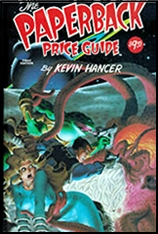
KEVIN HANCER – The Paperback Price Guide. Harmony Books / Overstreet Publications, softcover, 1980.
A friend of mine gave me some good advice once. “Never,” he said, “throw anything away before it starts to smell.â€
In this age of compulsive collectibles and instant nostalgia, that’s not such a bad idea. Besides guides for collectors of antiques in general, there are price guides as well for old baseball cards and old comic books, for example, basic commodities of life that have always given mothers such bad reputations (for throwing them away once our backs were turned). There are price guides for old phonograph records, both 45s and 78s, and yes, heaven help us, for beer cans as well, complete with full-color illustrations.
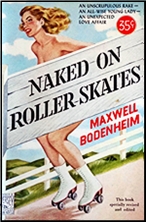
Joining the illustrious company of these and doubtless many others, the hobby of collecting old paperback books has come now into its own. Besides the obvious goal of determination and the compilation of current going prices, using some scheme known only to him – there is little or no relation to any asking prices I have seen, but more about that later – the greatest service that Hancer has given the long-time collector is that he has put together in one spot a more-or-less complete listing, by publisher, of all the mass-market paperbound books that were sold originally in drugstores and supermarkets across the country, for prices that from the first were almost always twenty-five cents each.

By 1960, however, they had crept upward to the thirty-five cent level, or so. (Now , twenty years later again, check the prices of paperbacks in the bookstores today, if you dare.)
Made superfluous are all the various checklists produced by specialist collectors and appearing in mimeographed forms in various short-lived periodicals over the past few years, signall1ng the big boom of interest about to come.
Many early paperbacks were mysteries, and mystery fans have collected them in lieu of the more expensive first editions for some time. An added attraction the cheaper paper editions always had to offer was the cover artwork, designed not-so-subtly to catch the would-be buyer’s eye, but now categorized as GGA. Good Girl Art, that is, a term coined by a comic book dealer, I think.
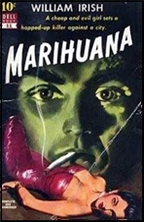
It speaks volumes for itself, as does the title Naked on Roller Skates, a book by Maxwell Bodenheim which lists for $30. Dell “mapbacks” go high, although most of them still lie in the $5 to $20 range, and so does early science fiction. The first Ace Double goes for $100, however, in mint condition, and a book entitled Marihuana goes for the same amount. The latter was published in 1951, when you could have picked up a copy, had you but known, for ten cents. Last month I could have bought a copy for a mere $13.
Another friend of mine has a theory about scarcity and price guides, and it goes something like this. Whenever the price of something is forced upward by artificial hype, he says, sooner or later it gets so high that no one wants it. If you have it, your only alternative is to find another fool to take it off your hands. The last person who ends up with it and cannot sell it is thereby crowned the Greatest Fool of Them All.
Check out your basements and attics now.